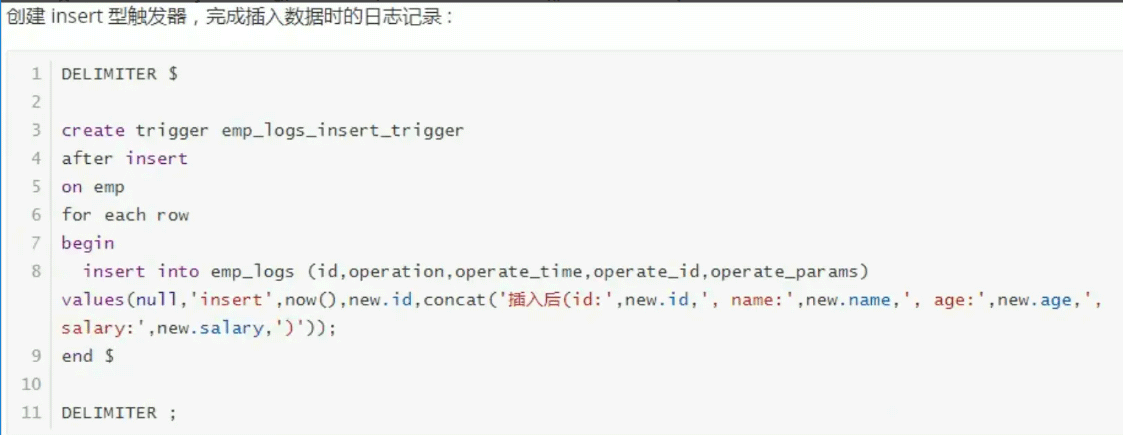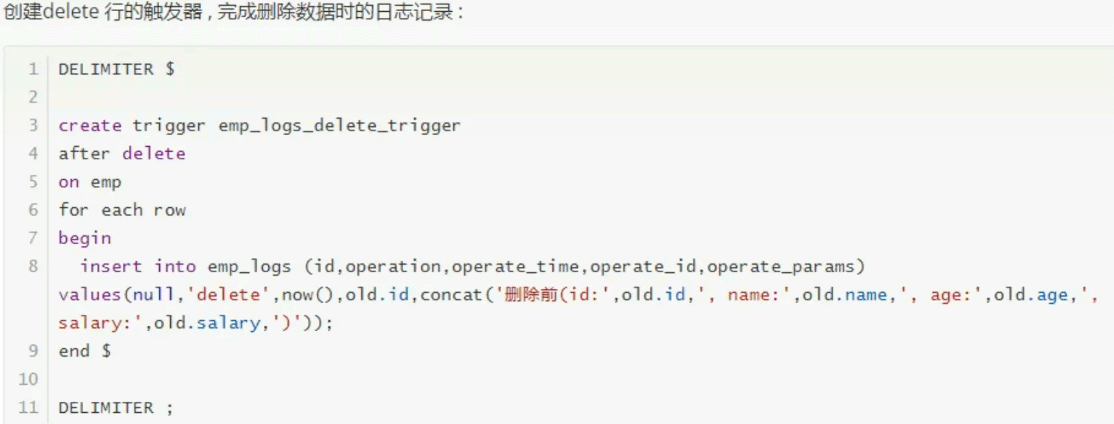How to customize functions and triggers in MySQL
1. Stored function (custom function)
Custom function is a way to extend MySQL, and its usage is the same as the built-in function.
Two necessary conditions for defining a function: parameters and return value. Functions can return values of any type and can also receive parameters of these types.
About the function body:
The function body is composed of legal SQL statements.
The function body can be a simple SELECT or INSERT statement.
If the function body conforms to the structure, it is wrapped with the BEGIN....AND statement.
Compound structures can contain declarations, loops, control structures, etc.
Important: Custom functions cannot have the same name, just like defining a global variable, the variable names cannot be consistent.
1.1 Define stored function
Syntax format:
create function 函数名(参数列表)
returns type(返回值类型)
begin
--SQL语句
end;Requirements: Define a function of a stored procedure, Get the total number of records that meet the conditions
Implementation:
delimiter $
create function fun(countryId int)
returns int
begin
# 定义一个存储总数据条数的变量
declare cum int default 0;
# 查询等于传递参数的全部的数据数,然后将其赋值给定义的变量
select count(*) into cum from city where country_id = countryId;
# 返回结果值。存储函数必须有返回值
return cum;
end $
delimiter ;1.2 Call the storage function
Syntax format:
select 函数名(参数列表);
Note: The call keyword is used when calling a stored procedure, but you can directly use select when calling a stored function, just like calling an ordinary aggregate function in MySQL.
select fun(1); # 这里和存储过程一样,调用的时候需要加小括号和参数,但是在删除的时候指定函数名即可
1.3 Delete stored function
Syntax format
drop [if exists] function fun;
2. Trigger
2.1 Trigger introduction
A trigger is a database object related to a table, which refers to triggering and executing the SQL set defined in the trigger before or after insert/update/delete. This feature of triggers can help applications ensure data integrity, logging, and data verification on the database side.
- Triggers can only be used when adding, deleting, or modifying, but not when querying.
- In triggers, use the OLD and NEW aliases to reference the changed parts of the record, similar to other databases. MySQL triggers only support row-level triggering and do not support statement-level triggering. Oracle supports both row-level and statement-level triggers.
- The two variables OLD and NEW are also called row record variables.
You can use these two variables to obtain the data in the data table to be operated.
 ##2.2 Create trigger
##2.2 Create trigger
create trigger(触发器) trigger_name(触发器名称)
before/after insert/update/delete
on tab_name(表名)
[for each row](行级触发器)
begin
trigger_stmt;(触发器的逻辑)
end;
Implementation:
Analysis:
A trigger can only operate one type of data operation, and cannot complete the operations of adding, modifying, and deleting at the same time. Therefore, multiple triggers need to be defined at this time to complete this logging task.
Because MySQL is a trigger for row-level operations, new and old store an entire row of data.Create a trigger to execute insert:

- In insert mode , use the keyword new to get the data to be inserted
- The after is used, and this trigger is executed to record the log after the addition of the table emp is completed.
- When this trigger is executed depends on two points:
- Must perform insert operation.
- Must operate It is the emp table, which is the table declared after on.

Create a trigger to execute delete:

Test: The test must be the emp table of the operation, so that the above will be triggered Defined trigger.
 2.3 Delete trigger
2.3 Delete trigger
drop trigger [schema_name.](数据库名)trigger_name(触发器名);
2.4 View triggers
You can view the status, syntax and other information of triggers by executing the show triggers command.
Grammar structure:The above is the detailed content of How to customize functions and triggers in MySQL. For more information, please follow other related articles on the PHP Chinese website!show triggers;

Hot AI Tools

Undresser.AI Undress
AI-powered app for creating realistic nude photos

AI Clothes Remover
Online AI tool for removing clothes from photos.

Undress AI Tool
Undress images for free

Clothoff.io
AI clothes remover

Video Face Swap
Swap faces in any video effortlessly with our completely free AI face swap tool!

Hot Article

Hot Tools

Notepad++7.3.1
Easy-to-use and free code editor

SublimeText3 Chinese version
Chinese version, very easy to use

Zend Studio 13.0.1
Powerful PHP integrated development environment

Dreamweaver CS6
Visual web development tools

SublimeText3 Mac version
God-level code editing software (SublimeText3)

Hot Topics
 1662
1662
 14
14
 1419
1419
 52
52
 1312
1312
 25
25
 1262
1262
 29
29
 1235
1235
 24
24
 MySQL's Role: Databases in Web Applications
Apr 17, 2025 am 12:23 AM
MySQL's Role: Databases in Web Applications
Apr 17, 2025 am 12:23 AM
The main role of MySQL in web applications is to store and manage data. 1.MySQL efficiently processes user information, product catalogs, transaction records and other data. 2. Through SQL query, developers can extract information from the database to generate dynamic content. 3.MySQL works based on the client-server model to ensure acceptable query speed.
 Laravel Introduction Example
Apr 18, 2025 pm 12:45 PM
Laravel Introduction Example
Apr 18, 2025 pm 12:45 PM
Laravel is a PHP framework for easy building of web applications. It provides a range of powerful features including: Installation: Install the Laravel CLI globally with Composer and create applications in the project directory. Routing: Define the relationship between the URL and the handler in routes/web.php. View: Create a view in resources/views to render the application's interface. Database Integration: Provides out-of-the-box integration with databases such as MySQL and uses migration to create and modify tables. Model and Controller: The model represents the database entity and the controller processes HTTP requests.
 How to start mysql by docker
Apr 15, 2025 pm 12:09 PM
How to start mysql by docker
Apr 15, 2025 pm 12:09 PM
The process of starting MySQL in Docker consists of the following steps: Pull the MySQL image to create and start the container, set the root user password, and map the port verification connection Create the database and the user grants all permissions to the database
 MySQL and phpMyAdmin: Core Features and Functions
Apr 22, 2025 am 12:12 AM
MySQL and phpMyAdmin: Core Features and Functions
Apr 22, 2025 am 12:12 AM
MySQL and phpMyAdmin are powerful database management tools. 1) MySQL is used to create databases and tables, and to execute DML and SQL queries. 2) phpMyAdmin provides an intuitive interface for database management, table structure management, data operations and user permission management.
 Solve database connection problem: a practical case of using minii/db library
Apr 18, 2025 am 07:09 AM
Solve database connection problem: a practical case of using minii/db library
Apr 18, 2025 am 07:09 AM
I encountered a tricky problem when developing a small application: the need to quickly integrate a lightweight database operation library. After trying multiple libraries, I found that they either have too much functionality or are not very compatible. Eventually, I found minii/db, a simplified version based on Yii2 that solved my problem perfectly.
 Laravel framework installation method
Apr 18, 2025 pm 12:54 PM
Laravel framework installation method
Apr 18, 2025 pm 12:54 PM
Article summary: This article provides detailed step-by-step instructions to guide readers on how to easily install the Laravel framework. Laravel is a powerful PHP framework that speeds up the development process of web applications. This tutorial covers the installation process from system requirements to configuring databases and setting up routing. By following these steps, readers can quickly and efficiently lay a solid foundation for their Laravel project.
 MySQL vs. Other Programming Languages: A Comparison
Apr 19, 2025 am 12:22 AM
MySQL vs. Other Programming Languages: A Comparison
Apr 19, 2025 am 12:22 AM
Compared with other programming languages, MySQL is mainly used to store and manage data, while other languages such as Python, Java, and C are used for logical processing and application development. MySQL is known for its high performance, scalability and cross-platform support, suitable for data management needs, while other languages have advantages in their respective fields such as data analytics, enterprise applications, and system programming.
 MySQL for Beginners: Getting Started with Database Management
Apr 18, 2025 am 12:10 AM
MySQL for Beginners: Getting Started with Database Management
Apr 18, 2025 am 12:10 AM
The basic operations of MySQL include creating databases, tables, and using SQL to perform CRUD operations on data. 1. Create a database: CREATEDATABASEmy_first_db; 2. Create a table: CREATETABLEbooks(idINTAUTO_INCREMENTPRIMARYKEY, titleVARCHAR(100)NOTNULL, authorVARCHAR(100)NOTNULL, published_yearINT); 3. Insert data: INSERTINTObooks(title, author, published_year)VA




